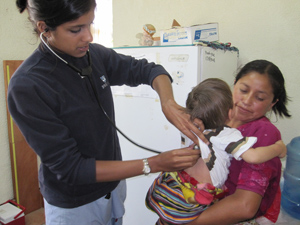 Ganguli (Katherine Lambert)
Ganguli (Katherine Lambert)
The clinic starts at 5 p.m. sharp with a team huddle in the conference room. A black plastic tray of stale bagel halves and crusted cantaloupe sits on the table, remnants of a breakfast meeting, but despite our medical-student hunger, we focus on the task at hand.
At 5:15, patients start to arrive. Their paths have been carefully choreographed from waiting room to exam table, lab to social services. Our schedules, through vigorous debate, have been set to five-minute time slots and annotated in flow charts. The first- and second-year medical students take blood pressures and interview the patients. The senior students finish the exam and present each patient’s case — from poison ivy to possible kidney failure — to the supervising doctor, using practice guidelines printed in our thick orientation packets.
Other students fill in as patient coordinators, social workers, and lab directors, while the research and quality assurance team tracks data on patients’ health needs and wait times. The M.D./MBA candidates in the group designed the clinic’s business model with the goal of self-sustainability, but for now, we simply do our best to take care of our patients.
Each Tuesday evening, the internal medicine practice at Massachusetts General Hospital lends its facilities to Harvard Medical School’s new student-faculty collaborative practice — the Crimson Care Collaborative (CCC). Medical schools across the country have similar student-run clinics, some decades old. More than a chance to play doctor, the clinic is a hands-on lesson in practicing primary care, the sort that forms the cornerstone of the “accountable care organizations” or “patient-centered medical homes” encouraged by the federal health overhaul law.
This evolving conception of primary care requires doctors and other primary health care providers to work in teams and to be creative about how they deliver care. Lawmakers have come to realize that it is critical for both improving our nation’s health and saving our wallets. Now medical training needs to change in kind.
My initial regard for primary care when I entered Harvard Medical School has been distorted by frustrations I hear from practicing doctors and the not-so-subtle lure of a “lifestyle career” alternative, my putative reward for being smart and working hard.
Yet when I spend time at the Crimson Care Collaborative or at the primary care clinic that occupied my Wednesday afternoons for a year, I am reminded of what draws me to this field — patients like the soft-spoken college student who came to see us at CCC because his volatile digestive tract made it hard for him to go to class, let alone work his two side jobs. The diagnosis was potentially life-altering, and it was our job to piece together his story, to explain what we were thinking, and to arrange for him to get the lab tests and the colonoscopy which ultimately showed (thank goodness) that his condition wouldn’t require lengthy hospital stays and could be treated, with close attention, through outpatient visits.
This is what makes primary care interesting — relationships with patients, the intrigue of new diagnoses, and the challenge of coordinating and optimizing care.

Ganguli during her rotation in Guatemala.
We know that the US health care system needs more primary care doctors as the number of practitioners entering and staying in the field dwindles and the number of patients increases — more than 30 million are expected to get insurance through the new health care law.
Last September, the American Association of Medical Colleges predicted that “there will be 45,000 too few primary care physicians — and a shortage of 46,000 surgeons and medical specialists — in the next decade.”
In response, since 2000 nearly two dozen new medical schools have opened or are being planned, for the first time in decades. The health overhaul seeks to entice more medical school graduates to fill these roles by redistributing unused residency training spots to primary care and offering new programs to repay the loans of graduates who work in underserved areas. Researchers at the George Washington University School of Medicine and Health Sciences have even introduced a new ranking system for medical schools based on fulfilling the so-called “social mission,” which includes producing a certain number of primary care doctors.
But reducing the primary care shortage to a problem of supply, demand, and geography misses a critical point: that answering the nation’s workforce needs means more than mass-producing more doctors and nurses; it requires training practitioners who can deliver the kind of care our country requires.
For one thing, the benefits of loan reduction programs are quickly lapped by the margin of hundreds of thousands of dollars in income that specialists gain each year. A better way to encourage medical students to enter primary care is to make it more fulfilling to practice, and not just by adjusting payment structures (though this is important). The key is to expose future doctors to primary care early and to teach the skills needed by all doctors (but especially those in primary care): teamwork and a dynamic understanding of health care systems.
Historically, these skills have been given short shrift in medical schools.
I had little formal exposure to my future health care colleagues throughout medical school; I had no idea, for example, what physician assistants did and how they trained. I only found out when one morning in my third year of medical school I asked a physician assistant joining us for morning rounds because I was curious and frankly, embarrassed by my ignorance.
As I moved between rotations in surgery, pediatrics, and neurology, my charge was to fit in. So it was hard not to adopt the half-joking superiority over other specialties espoused by some of the residents and senior doctors with whom I worked.
I’d hear hospitalists deriding hastily written patient notes from emergency medicine doctors, and those emergency doctors griping about primary care doctors who sent their patients to the emergency room without having seen them first. There were perfectly good explanations for brief notes and unscreened referrals (in short, lack of time), but loyalty to my team-of-the-moment had to trump my sympathies with other fields, so I was wary of speaking up. At the same time, while I called the doctors I worked with my “teammates,” I had little idea how to make the most of these relationships or what to do if they went sour. But as my friends in business school tell me, this may be a teachable skill.
Doctors need to be taught not only how to manage teams, but when to let others take charge, said Dr. Robert Kocher, former member of the National Economic Council under President Barack Obama and special assistant to Obama on health care. “We need doctors who work flawlessly and without ego with nurses, [nurse practitioners], physician assistants ” he said in an interview.
We also need to understand the health care system – not just the history of Medicare, but the ins and outs of billing, malpractice, and quality measures – so that we can effectively work within, and on, this system. Student-run clinics are one way to do this. At the Crimson Care Collaborative, we learned to make real-time improvements in the way we deliver care that would be impossible at a large hospital center. There are plenty of other promising ideas.
Medical students at the University of Texas Medical Branch partner with physical therapy and nursing students in anatomy lab, early in their training. At the University of Pennsylvania, students visit the Wharton School of Business to learn how car manufacturing standards can be applied to health care. At Tufts and Columbia, medical students can enroll in a primary care track in a rural setting that is dedicated to skills like teamwork and quality improvement. Harvard Medical School’s recently announced $30 million Center for Primary Care promises opportunities for students to work with clinicians on practice-improvement projects.
As the realities of our flawed health care system are brought to the forefront, primary care is becoming the purview of trainees interested in a broad perspective of this system and the desire to improve it. If we’re equipped with the skills to do this, I believe more of us will not only choose primary care, but also will practice it better.
Ishani Ganguli is a freelance journalist and a fifth year medical student at Harvard Medical School. She is a member of
Primary Care Progress, a Boston-based non-profit organization that promotes innovation in primary care training and delivery.






